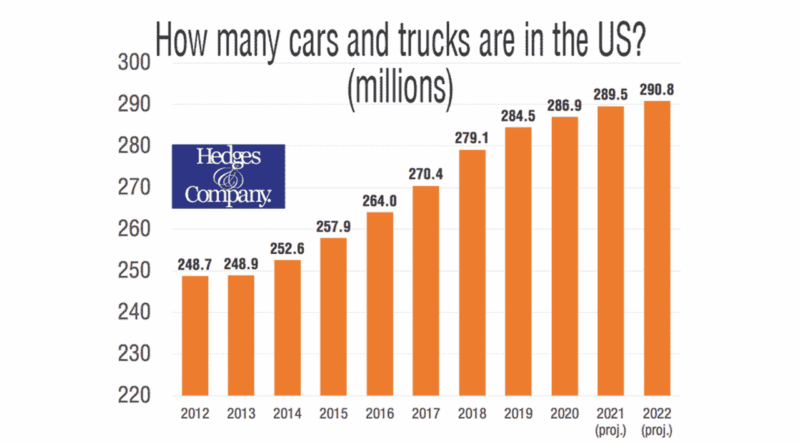US Needs to Triple EV Sales to Start Reducing ICE Vehicle Fleet
Zach’s recent post on the bump in Q3 ICE and EV sales brought up a question: How far do we have to go before EVs start reducing the total number of ICE vehicles on the road?
Looking at the latest data from Hedges & Company, from 2012 (248.7 million) to 2024 (296.6 million), the US fleet grew by an average of 4 million vehicles per year. Over the same period, sales averaged slightly over 16 million vehicles per year. In other words, roughly ¾ of sales replace vehicles taken off of the road and ¼ add to the fleet.
In total, roughly 4 million EVs were on the road in the US as of the end of 2024, according to Experian. In other words, roughly as many in cumulative total as the overall vehicle fleet grows in an average year, and less than 2% of total vehicles on the road. According to Argonne, 6.25 million EVs had been sold in total in the US by the end of 2024. Beyond measurement variances, the gap indicates that, while EVs may be durable and low maintenance, we are still seeing retirements. EVs are not impervious to accidents and the test of time. As those vehicles get older, repairability will become more of a concern. It will be interesting to see the rate of scrappage now that some EVs are becoming older than the average age of vehicles on the road.
In 2024, the average light vehicle on the road was 12.6 years old and is expected to top 13.4 years old by the end of the decade. The removal of emissions and safety inspections in many states is poised to extend that age. In comparison, vehicles are replaced faster in China, with tightening emissions, mandatory scrappage for inspection failures, and scrappage incentives taking older ICE vehicles off the road. In combination with over 50% EV market share, China is reducing its ICE vehicle fleet at a significant rate.
Last quarter, EV sales broke 10% market share for the first time due to sales being pulled forward by the end of incentives. However, when looking at the sales year as a whole, roughly 8% market share is projected. With companies scaling back EV production and consumer subsidies ended, 2026 may be lucky to do as well.
Overall, we need EVs to reach roughly 25% of sales to stop ICE fleet growth, or approximately three times what EV sales are projected to be this year. Something will need to change to multiply sales to that level. And it will take even higher sales to start reducing the size of the fleet. Even when EVs make up the majority of sales, it will take a while to replace the over 50 million ICE vehicles added to the fleet since the Volt and Leaf were introduced early last decade.
That is not to say that current EV sales do not help. The ICE fleet could be even larger. However, we need to do much more. Eventually, we may need to start thinking about programs that take older ICE vehicles off the road. We may have to start implementing ICE disincentives, like look at increasing gas taxes to cover the Highway Trust Fund shortage (with a growing ICE fleet size, you can’t blame that on EVs). We need to start opening up trade to lower prices and increase EV adoption. The elimination of federal consumer subsidies didn’t help. But we need to do much more if we intend to reduce the ICE fleet size and the long-term CO2 emissions it creates.
Sign up for CleanTechnica's Weekly Substack for Zach and Scott's in-depth analyses and high level summaries, sign up for our daily newsletter, and follow us on Google News!
Have a tip for CleanTechnica? Want to advertise? Want to suggest a guest for our CleanTech Talk podcast? Contact us here.
Sign up for our daily newsletter for 15 new cleantech stories a day. Or sign up for our weekly one on top stories of the week if daily is too frequent.
CleanTechnica's Comment Policy
